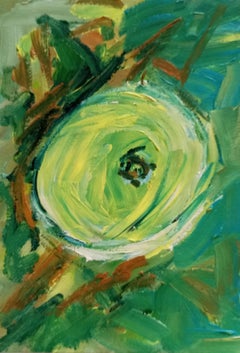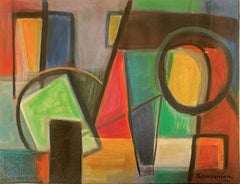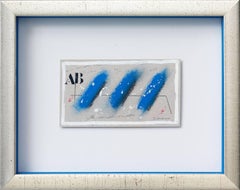James Coignard Abstract Drawings and Watercolors
French, b. 1925
James Coignard, painter, ceramist, sculptor and etcher, was born in Tours in 1925. At the age of 23 and after a brief career in the French administration, he discovers the landscapes of the French Riviera and decides to study at Arts décoratifs in Nice. Four years later, he quits his job at the administration to commit himself entirely to his artistic career. The encounter with Paul Hervieu in 1950 is decisive. His collaboration with gallery Hervieu made him known in artistic circles, nationally and internationally and then particularly in Scandinavia. At the beginning of his career, art critics label James Coignard as a member of Ecole de Paris. Soon, his painting and ceramic distances themselves from those of his colleagues and he goes it alone. At the beginning of the sixties, he starts to work with glass but the technical turning point occurs in 1968 when his friend Henri Goetz discovers a new etching technique, using carborundum. Etching then becomes central in his work. At the same time, his career takes off internationally. He travels a lot, especially to Sweden and USA where he lives during a few years. 1978, James Coignard participates in the creation of the etching studio Pasnic, with which he starts a long collaboration. During the eighties, he shares his time between Paris and the French Riviera and takes an interest in artist’s books and publishing issues. He exhibits now all over the world, and is acknowledged as one of the greatest painter-etchers of his time. Until his decease in 2008, James Coignard was a prolific painter, sculptor and etcher and leaves behind an immense work.to
1
Overall Width
to
Overall Height
to
1
1
1
1
1
1
53
138
110
94
77
1
1
Artist: James Coignard
Abstract composition JCI, 1960-65 - mixed media, 85x124 cm, framed
By James Coignard
Located in Nice, FR
Mixed media, gouache and paper, signed .
James Coignard est un peintre, graveur et sculpteur français, né le 15 septembre 1925 à Tours et mort le 7 mars 2008 à M...
Category
Mid-20th Century Abstract James Coignard Abstract Drawings and Watercolors
Materials
Paper, Oil
Related Items
"Just a lemon"
Located in VÉNISSIEUX, FR
Dear art lover,
I have worked on a new series of small oil paintings dedicated to a summer period.
This artwork called "Just a lemon" is done with oil ...
Category
2010s Abstract Impressionist James Coignard Abstract Drawings and Watercolors
Materials
Oil, Paper
"Colorful Geometric Abstraction, " Simon Samsonian, Armenian Artist
Located in New York, NY
Simon Samsonian (1912 - 2003)
Colorful Geometric Abstraction, 1981
Oil on paper
16 x 22 inches
Signed and dated lower right
Provenance:
Estate of the artist
This survivor of the Armenian genocide wound up in a Cairo orphanage in 1927. He rose to fame as one of Egypt’s great modernists, but after moving to Long Island late in life he withdrew into anonymity. Now his compelling story is being told. Art historians are finally beginning to realize that the power of abstraction in its early years was a zeitgeist not limited to the major European centers of the avant-garde — Paris, Munich, and Moscow — but one that quickly rippled to major cities throughout the world. Within a few decades that original shock of a new vision had inspired thousands of artists from different cultures — particularly those the Middle East — whose translations were not slavish imitations of works by seminal figures like Picasso, Braque, Malevich, and Kandinsky but creative variants colored by their respective cultures.
This essay focuses on an extraordinary Armenian artist, his harrowing survival of the genocide, his rise to fame in Cairo, and his creation of a unique style of abstraction. Art historians have typically formed a chorus that teaches the history of abstraction like this: Just before and during the World War I era, several avant-garde artists emerged to create shockingly different new forms by which artists could express themselves. In Paris, Picasso and Braque broke out with cubism, quickly followed by Mondrian. In Moscow, Malevich created Suprematism, the ultimate hard-edge geometric abstraction. And in Munich, Kandinsky emerged as the father of Abstract Expressionism. Within these few short years a zeitgeist was sensed throughout the art world. American pioneers, too — particularly Stanton Macdonald-Wright and Morgan Russell — felt this explosive freedom of expression. When Europe was recovering after World War I it became clear that Paris would retain its title as capitol of the art world, lasting through the Roaring Twenties and even through the Great Depression. But the end of World War II changed everything. A parallel war had been won by a group of irascible young Abstract Expressionists in New York — led by Pollock, Rothko, DeKooning, and Kline. No sooner had Paris been liberated from the Germans than Picasso, Matisse, Breton, and Duchamp surrendered to the Americans. From that point on New York would be the epicenter of the art world.
But a lens that focuses myopically on the war between the avant-garde of Paris and New York misses the wider narrative of multiple aesthetic modernities that developed in the several decades following World War I. For Armenian artists the matter is even more complex owing to the genocide of 1915 where more than 1.5 million people — seventy-five percent of Armenians in the Ottoman Empire — were massacred. Those not shot on the spot were sent on death marches through the Mesopotamian desert without food or water. Frequently, the marchers were stripped and forced to walk naked under the scorching sun until they dropped dead.
As a child Samsonian witnessed the murder of his parents and most of the members of his family. Soon thereafter, his older sister, Anahid, quickly shepherded him into a line of children being rescued by Greek nuns. But they became separated and he lost her, too. He was sent to a Greek orphanage in Smyrna (now Izmir), on Turkey’s west coast. Because he only knew his first name, the orphanage gave him a last name based on the place where they found him — Samsun — a major port on Turkey’s north coast on the Black Sea. His birth date was unknown, too. According to Samsonian’s vague recollections he assumed he was about three or four years old at the onset of the genocide, which would place his birth year in 1911 or 1912. In 1922, when Samsonian was about 10, the Turks ended their war with the Greeks by putting Smyrna to the torch in what has been called the “Catastrophe of Smyrna.” Once again, the child was on the run, escaping the fire and slaughter. He found temporary refuge in Constantinople, but within a year that major port would fall to the Turks, too, and become renamed as Istanbul. This time, Samsonian was whisked away to an orphanage in Greece founded by the American charity, Near East Relief — which is credited with saving so many Armenian orphans that the American historian Howard M. Sachar said it “quite literally kept an entire nation alive.
Any understanding of Samsonian’s approach to modernism requires careful consideration of the impact of his early years because his art is inseparable from the anguish he experienced. In 1927, when he was a teenager, he was transferred to Cairo, Egypt, then a cosmopolitan city hosting a sizable portion of the Armenian diaspora. There he lived with thirty-two other children on the top floor of the Kalousdian Armenian School. Upon graduating in 1932 he won a scholarship to attend the Leonardo da Vinci Art Institute — an Italian art school in Cairo — where he won first prize in final examinations among one hundred students. He found work with an Armenian lithographic printer and he returned to the Kalousdian Armenian School to teach drawing. In 1939 he married one of his students, Lucy Guendimian.
The Cairo in which Samsonian matured as an artist was home to many prominent art collectors after World War I. In this receptive environment Samsonian exhibited widely and won many awards. Beginning in 1937 and for the next thirty years he exhibited annually at the prestigious Le Salon du Caire hosted by the Société les Amis de l’Art (founded in 1921). After World War II he hit his stride as a modernist in Cairo, counting among his peers other artists of the Armenian diaspora such as Onnig Avedissian, Achod Zorian, Gregoire Meguerdichian, Hagop Hagopian...
Category
1980s Abstract Geometric James Coignard Abstract Drawings and Watercolors
Materials
Paper, Oil
"Untitled" Hans Hofmann, circa 1943 Navy Blue Olive Green Early Abstract Work
By Hans Hofmann
Located in New York, NY
Hans Hofmann
Untitled, circa 1943
Signed lower right
Oil and watercolor on paper
22 1/4 x 30 3/4 inches
The only artist of the New York school to participate directly in European m...
Category
1940s Abstract Expressionist James Coignard Abstract Drawings and Watercolors
Materials
Paper, Oil, Watercolor
German School "Pfauvogel"
Located in Astoria, NY
German School, "Pfauvogel" [Peacock], Oil and Watercolor on Paper, 1962, illegibly signed "R. Arzt (?)" and dated lower right, titled lower left, giltwood frame. Image: 20.75" H x 16...
Category
1960s Abstract James Coignard Abstract Drawings and Watercolors
Materials
Paper, Watercolor, Oil
Follow the pink rabbit - line drawing woman figure
By Mila Akopova
Located in Fort Lee, NJ
Interior design paintings. The artwork were done with oil, acrylic, ink and watercolor. The work are 11 by 14 inches in size, framed (black) with a styrene face on a mat board in whi...
Category
2010s Abstract James Coignard Abstract Drawings and Watercolors
Materials
Paper, Acrylic, Watercolor, Oil
Canto #22 (Abstract work on paper)
By Harald Kroner
Located in London, GB
Canto #22 (Abstract work on paper)
Ink, oil on paper - unframed
This artwork will be shipped rolled in a dent-resistant tube.
Harald Kröner works thoroughly with paper, of which h...
Category
2010s Abstract James Coignard Abstract Drawings and Watercolors
Materials
Paper, Ink, Oil
Good Friday, abstract female figure
By Tom Bennett
Located in Brooklyn, NY
Oil on paper, signature Tom Bennett freedom of rich brushwork, warm colors
Category
2010s Abstract Expressionist James Coignard Abstract Drawings and Watercolors
Materials
Paper, Oil
Conference of the birds no 40
By Yari Ostovany
Located in London, GB
Oil on paper. Unframed.
Natural and mystical processes inspire Ostovany. Informed by a variety of different cultures, Ostovany feels a connection to multiple separate and yet complementary mystical traditions.
He looks toward elements of Western and Eastern art, literature, spirituality, poetry and music to create an environment and a mindset conducive to his process, which is connected to Abstract Expressionism and Color Field painting.
Conference of the Birds...
Category
Early 2000s Abstract Expressionist James Coignard Abstract Drawings and Watercolors
Materials
Paper, Oil
Emily Berger, Small Blue Swag , 2016, oil on synthetic paper, Abstraction
By Emily Berger
Located in Darien, CT
These paintings and drawings are based on a structure of repetitive and deliberate gesture that is intuitive but carefully considered. Emily Berger brushes, wipes, rubs, and scrapes,...
Category
2010s Abstract James Coignard Abstract Drawings and Watercolors
Materials
Synthetic Paper, Oil
Untitled 2310 (Abstract Drawing)
By Fieroza Doorsen
Located in London, GB
Untitled 2310 (Abstract Drawing)
Oil on paper - Unframed.
In her abstract drawings, collages and paintings, Fieroza Doorsen brings to life the tensions and harmonies that emerge wh...
Category
2010s Abstract James Coignard Abstract Drawings and Watercolors
Materials
Paper, Oil
Untitled (ID 1276)
By Fieroza Doorsen
Located in London, GB
Oil and pastel on paper - Unframed
In her abstract drawings, collages and paintings, Fieroza Doorsen brings to life the tensions and harmonies that emerge when structure meets intui...
Category
2010s Abstract James Coignard Abstract Drawings and Watercolors
Materials
Paper, Pastel, Oil
Into the Sunset
By Andrei Petrov
Located in New York, NY
Andrei Petrov is an American artist of Russian origins. He is best known for his abstract oil paintings where calibrated stratifications of intense shades of colors are scraped to ex...
Category
2010s Abstract Expressionist James Coignard Abstract Drawings and Watercolors
Materials
Paper, Oil
Previously Available Items
Trois bleus en diagonale.
By James Coignard
Located in Malmo, SE
Acquired directly from the artist.
Unique artwork.
Artwork size: 9,5 x 17 cm.
Frame size: 27 x 34 cm
Frame in silver.
Museum glass anti-reflective.
Free shipment worldwide.
“With ju...
Category
Early 2000s Abstract James Coignard Abstract Drawings and Watercolors
Materials
Mixed Media
James Coignard abstract drawings and watercolors for sale on 1stDibs.
Find a wide variety of authentic James Coignard abstract drawings and watercolors available for sale on 1stDibs. You can also browse by medium to find art by James Coignard in mixed media, oil paint, paint and more. Much of the original work by this artist or collective was created during the 21st century and contemporary and is mostly associated with the abstract style. Not every interior allows for large James Coignard abstract drawings and watercolors, so small editions measuring 14 inches across are available. Customers who are interested in this artist might also find the work of Claude Tétot, Lelia Pissarro, and Margo Margolis. James Coignard abstract drawings and watercolors prices can differ depending upon medium, time period and other attributes. On 1stDibs, the price for these items starts at $1,112 and tops out at $3,495, while the average work can sell for $2,304.


